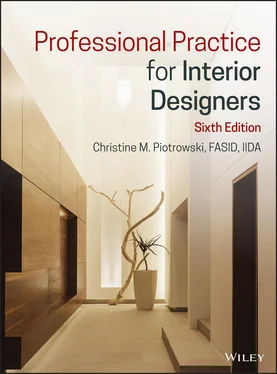Christine M. Piotrowski - Professional Practice for Interior Designers
Здесь есть возможность читать онлайн «Christine M. Piotrowski - Professional Practice for Interior Designers» — ознакомительный отрывок электронной книги совершенно бесплатно, а после прочтения отрывка купить полную версию. В некоторых случаях можно слушать аудио, скачать через торрент в формате fb2 и присутствует краткое содержание. Жанр: unrecognised, на английском языке. Описание произведения, (предисловие) а так же отзывы посетителей доступны на портале библиотеки ЛибКат.
- Название:Professional Practice for Interior Designers
- Автор:
- Жанр:
- Год:неизвестен
- ISBN:нет данных
- Рейтинг книги:4 / 5. Голосов: 1
-
Избранное:Добавить в избранное
- Отзывы:
-
Ваша оценка:
- 80
- 1
- 2
- 3
- 4
- 5
Professional Practice for Interior Designers: краткое содержание, описание и аннотация
Предлагаем к чтению аннотацию, описание, краткое содержание или предисловие (зависит от того, что написал сам автор книги «Professional Practice for Interior Designers»). Если вы не нашли необходимую информацию о книге — напишите в комментариях, мы постараемся отыскать её.
Professional Practice for Interior Designers
Professional Practice for Interior Designers — читать онлайн ознакомительный отрывок
Ниже представлен текст книги, разбитый по страницам. Система сохранения места последней прочитанной страницы, позволяет с удобством читать онлайн бесплатно книгу «Professional Practice for Interior Designers», без необходимости каждый раз заново искать на чём Вы остановились. Поставьте закладку, и сможете в любой момент перейти на страницу, на которой закончили чтение.
Интервал:
Закладка:
Finally, thank the employer for taking the time to review the letter and resume. Use standard business style for the closing including the use of the word Enclosure if you are attaching or including a resume. Table 6‐2provides several tips for preparing a cover letter.
You want the employer to call you, but do not wait for the employer to respond. It is often recommended that you state you will be calling the employer concerning an appointment for an interview. This naturally is very important if you have decided to travel to a location for your job search. It is not a good idea to expect the employer to meet with you when you are ready. The last paragraph should include a reference to the enclosed resume as well as the availability of your portfolio for review.
TABLE 6‐2. Tips for preparing a cover letter
| • Address the letter by the employer's name—never “To Whom It May Concern.” |
| • When you can drop names, do so: “I was referred to your company by John Jones, the owner of Jones Thompson Flooring.” |
| • Discuss accomplishments and results. This goes for the resume as well. |
| • Be brief and concise. Use good grammar and correct spelling. |
| • It is okay to use industry jargon and buzzwords. However, you had better know what any jargon you put in your letter means. |
| • Do not include negative information (such as “I left ABC Interiors because of a disagreement with the owner”). This might come up in the interview, but you will have a better chance of explaining it then. |
| • Do not make your letter sound like you are begging for a job. |
| • Always say thank you at the end. |
PORTFOLIOS
Portfolios are of critical importance to an interior designer at any level of practice. This visual field requires visual “proofs” of one's ability to design interiors. Simply stated, a portfolio is a visual presentation of what you can do as an interior designer. The term portfolio is also used to refer to the binder in which the visual items are placed.
Your portfolio must show your best work. It should contain design work that relates to the design position you are seeking and the needs of the prospective employer. Something that Maureen Mitton, author of Portfolios for Interior Designers , suggests is to start by creating an inventory of the items you have available for a portfolio. This will help you create a portfolio that is individualized for each job interview.
Of course, in today's job market it is likely that all your portfolio items are digital. However, some employers may want to see original work if possible. This might especially be true of students. Digital photos can hide mistakes that viewing original work will reveal.
When you inventory your project work—either as a student or professional—be sure that what you include is your work. Be prepared to explain your roll in group projects. For professionals, it is important to make note that the work you produce as an employee belongs to the design firm, not the employee. When you decide to look for another job, association codes of conduct specifically state that you cannot take drawings or other documents without permission.
Your portfolio is never really “finished,” as it must be constantly updated and refined to meet current or expected needs in the job‐search process. This is true of students as well as a consideration by professionals. For the student, it must present the breadth of the student's abilities. For the experienced professional, the portfolio must show a range of work, with emphasis on the present. This is another reason to have a list of the potential portfolio items.
Students will include the digital presentations of projects prepared for classes at the upper level. The employer will want to see the type of work that you can do at the end of your academic career, not the beginning. For a professional, project photos are the bulk of your portfolio, and you need to show your work in the best way possible. Don't forget to negotiate the rights (permissions) to use the photos taken by professional photographers in your work portfolio, on your Web site, and in other marketing media.
Here are some quick tips on the overall concept of a portfolio for students as well as professionals:
Items should show that you have the skills for the job for which you are applying.
Portfolio items should be self‐explanatory even though you will most likely be presenting them to the prospective employer. Written explanations should not simply state what can be seen in the graphics.
Organization of the items is key to helping make your portfolio self‐explanatory. Remember that a portfolio tells a visual story about you.
Each piece that you include demonstrates how you can help the prospective employer.
What to Include
Because you may only have 30–60 minutes for the entire interview, you need to limit the number of items in your portfolio. Twenty‐five to thirty items or pages should be sufficient. This also ensures that you have time to ask your questions during the interview. Select items that show employers you have an understanding of the issues involved in designing interiors. This is especially important for students. You must include items that showcase your technical, creative, and problem‐solving skills. Table 6‐3provides suggestions as to what can be included in a portfolio.
A student must show a variety of items that will help demonstrate his or her skills in the techniques and processes of interior design. Begin with a high‐quality piece or a project that showcases a whole project. The items selected should be your best work and provide examples of all the skills you possess.
The professional may find it easier to emphasize certain types of work, but may also have to show the breadth of his experience in designing projects. Professionals will want to lead with a recent award‐winning project and may even include a copy of the award certificate. Be sure you obtain the client's permission to photograph the interiors and that you have permission to duplicate work done at your place of employment. The rights clause in a design contract that relates to photographs does not cover a designer's personal use of photos. So you may need to talk to the photographer about getting prints.
Digital portfolios can be prepared in a variety of ways. Items are easily saved on DVDs due to their large storage capacity. USB flash drives are also great because they can store a lot of material and are easy to carry. For security, however, it is best to use a DVD‐R read‐only disc so that the receiver/viewer cannot alter it. You can also secure the USB using the manufacturer's directions.
There are many options to preparing the actual digital presentation of your portfolio. Many types of software are available to help the candidate include animation, voice‐overs, and music to make it even more personalized. In addition, you control the timing, sequence, and pace of the information in your presentation.
These presentations can also be programmed into a personal Web site or posted to a Web site hosting interior design portfolios. Two sites that host interior design portfolios are www.slideshare.netand www.carbonmade.com, among others. Note that these are mentioned for reference and the author does not specifically endorse either. Other sites also allow portfolio postings.
TABLE 6‐3. Items commonly included in a portfolio
| Examples of these items should be included and organized to show your skills in relationship to the job for which you are applying. Be sure you only show work YOU did. If projects were done by teams, bring the parts you were responsible for, not what someone else did. |
| Students |
| • At least one complete project with all required documents |
| • Sketches that show the decision‐making process |
| • Freehand sketches and thumbnails |
| • Programming sketches or documents (i.e., bubble diagrams and adjacency diagrams) |
| • Furniture floor plans |
| • Working drawings |
| Dimensioned plans |
| Mechanical plans |
| Elevations, sections, and details |
| Millwork designs |
| • CAD drawings |
| • Manual drafting |
| • Color boards |
| • Exhibits of hand lettering skills |
| • Perspectives and/or isometric drawings |
| • Technical renderings in any media in which you are competent |
| Professionals |
| • Project photos or slides |
| • Publication reprints |
| • Articles you wrote |
| • Specifications |
You may be able to link your Web site with one of the job search sites. A caution for Web site portfolios is that you must be careful about image file size and the number of images you include. Employers may become impatient waiting for a complex portfolio to download. If the portfolio is sent as a large e‐mail or e‐mail attachment, the recipient's system may interpret it as spam.
Читать дальшеИнтервал:
Закладка:
Похожие книги на «Professional Practice for Interior Designers»
Представляем Вашему вниманию похожие книги на «Professional Practice for Interior Designers» списком для выбора. Мы отобрали схожую по названию и смыслу литературу в надежде предоставить читателям больше вариантов отыскать новые, интересные, ещё непрочитанные произведения.
Обсуждение, отзывы о книге «Professional Practice for Interior Designers» и просто собственные мнения читателей. Оставьте ваши комментарии, напишите, что Вы думаете о произведении, его смысле или главных героях. Укажите что конкретно понравилось, а что нет, и почему Вы так считаете.












